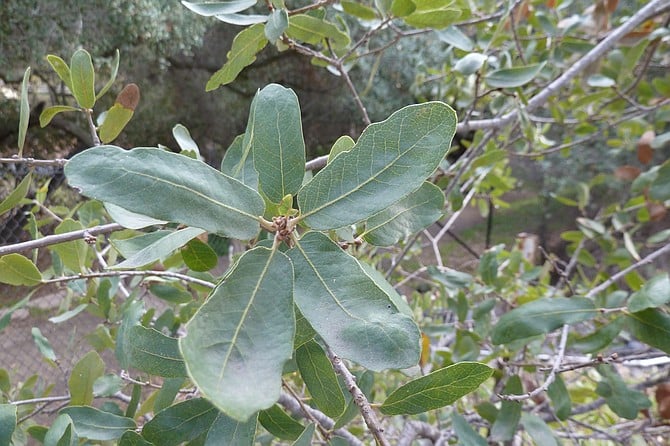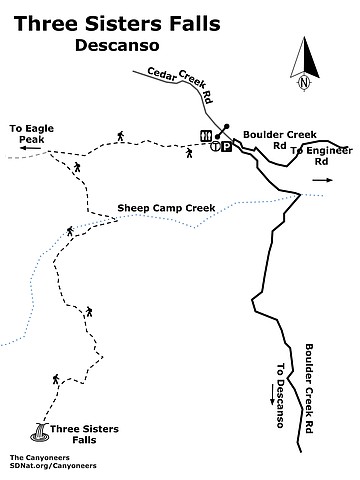 Facebook
Facebook
 X
X
 Instagram
Instagram
 TikTok
TikTok
 Youtube
Youtube

While the rest of North America is shoveling snow, San Diegans have the perfect venue for a hot day – hiking to Three Sisters Falls and taking a plunge in the frigid mountain water. The trail down to Boulder Creek was once rated as one of the hardest short hikes in San Diego. However, the trail has recently been re-aligned eliminating sections that previously required safety ropes. The trail still drops approximately 1,500 feet to the canyon floor and the steeper sections have little shade. Along with the elevation, the heat can be extreme if visiting during the summer. Temperatures can soar to 100 degrees, making water a primary planning consideration.
From the trailhead, it is almost two miles down to the top of the falls. At the start of the trail from the parking lot, visitors are greeted with a wide easy path. This section goes through open grassy areas with a variety of chaparral species including chamise, manzanita, and white sage. Across most of this open area are large sections of Engelmann oak (Quercus engelmannii). These gorgeous blue-green leafed oaks are one of the few native evergreen trees found throughout Southern California. Aside from other oak species and evergreen s in the high country, San Diego County has relatively few native tree species. They are drought deciduous, which means that they can drop their leaves to conserve water when heat stressed.
At just over 0.5 mile, the wide path ends and you reach a saddle with a weathered sign post. Continuing straight is the trail leading up to Eagle Peak. On your left is the trail down into the canyon. From here is a good view of Three Sisters Falls on the far side of the canyon. The trail quickly narrows as it descends to Sheep Camp Creek. At one mile, after crossing the creek, the trail flattens out and visitors are taken through a shaded riparian grove of oak and willow. If necessary, visitors can rest before making their final descent to the canyon floor as there are many spots allowing folks to sit off trail and out of the way of other travelers.
The path up to the falls is well marked, but visitors will have to climb over large sections of boulders to reach the top as they navigate up Boulder Creek Canyon. These rock surfaces can be very slippery, making the climb dangerous. An additional hazard is poison oak, which is all along the trail. During the warmer seasons, be on the lookout for rattlesnakes.
However, the climb is well worth it as visitors are greeted by the trail’s namesake—the Three Sisters Falls. The lower falls can be a trickle during the heat of summer, but in a wet winter, it becomes a rushing torrent that drops twenty feet into the frigid pool below. The route to the top section requires more rock scrambling and the use of ropes anchored into the granitic walls. Once at the top, the view of Boulder Creek Canyon and the falls is breathtaking.
Of course, what comes down must go up! Visitors will have to hike back up the nearly two miles of trail and 1,500 feet of hillside to get back to the trailhead and their vehicles. Another option is to pass the trail turning down and left to Three Sisters Falls and continue along the ridge to Eagle Peak.

THREE SISTERS FALLS
One of San Diego’s legendary trails gets a much needed face lift.


While the rest of North America is shoveling snow, San Diegans have the perfect venue for a hot day – hiking to Three Sisters Falls and taking a plunge in the frigid mountain water. The trail down to Boulder Creek was once rated as one of the hardest short hikes in San Diego. However, the trail has recently been re-aligned eliminating sections that previously required safety ropes. The trail still drops approximately 1,500 feet to the canyon floor and the steeper sections have little shade. Along with the elevation, the heat can be extreme if visiting during the summer. Temperatures can soar to 100 degrees, making water a primary planning consideration.
From the trailhead, it is almost two miles down to the top of the falls. At the start of the trail from the parking lot, visitors are greeted with a wide easy path. This section goes through open grassy areas with a variety of chaparral species including chamise, manzanita, and white sage. Across most of this open area are large sections of Engelmann oak (Quercus engelmannii). These gorgeous blue-green leafed oaks are one of the few native evergreen trees found throughout Southern California. Aside from other oak species and evergreen s in the high country, San Diego County has relatively few native tree species. They are drought deciduous, which means that they can drop their leaves to conserve water when heat stressed.
At just over 0.5 mile, the wide path ends and you reach a saddle with a weathered sign post. Continuing straight is the trail leading up to Eagle Peak. On your left is the trail down into the canyon. From here is a good view of Three Sisters Falls on the far side of the canyon. The trail quickly narrows as it descends to Sheep Camp Creek. At one mile, after crossing the creek, the trail flattens out and visitors are taken through a shaded riparian grove of oak and willow. If necessary, visitors can rest before making their final descent to the canyon floor as there are many spots allowing folks to sit off trail and out of the way of other travelers.
The path up to the falls is well marked, but visitors will have to climb over large sections of boulders to reach the top as they navigate up Boulder Creek Canyon. These rock surfaces can be very slippery, making the climb dangerous. An additional hazard is poison oak, which is all along the trail. During the warmer seasons, be on the lookout for rattlesnakes.
However, the climb is well worth it as visitors are greeted by the trail’s namesake—the Three Sisters Falls. The lower falls can be a trickle during the heat of summer, but in a wet winter, it becomes a rushing torrent that drops twenty feet into the frigid pool below. The route to the top section requires more rock scrambling and the use of ropes anchored into the granitic walls. Once at the top, the view of Boulder Creek Canyon and the falls is breathtaking.
Of course, what comes down must go up! Visitors will have to hike back up the nearly two miles of trail and 1,500 feet of hillside to get back to the trailhead and their vehicles. Another option is to pass the trail turning down and left to Three Sisters Falls and continue along the ridge to Eagle Peak.

THREE SISTERS FALLS
One of San Diego’s legendary trails gets a much needed face lift.